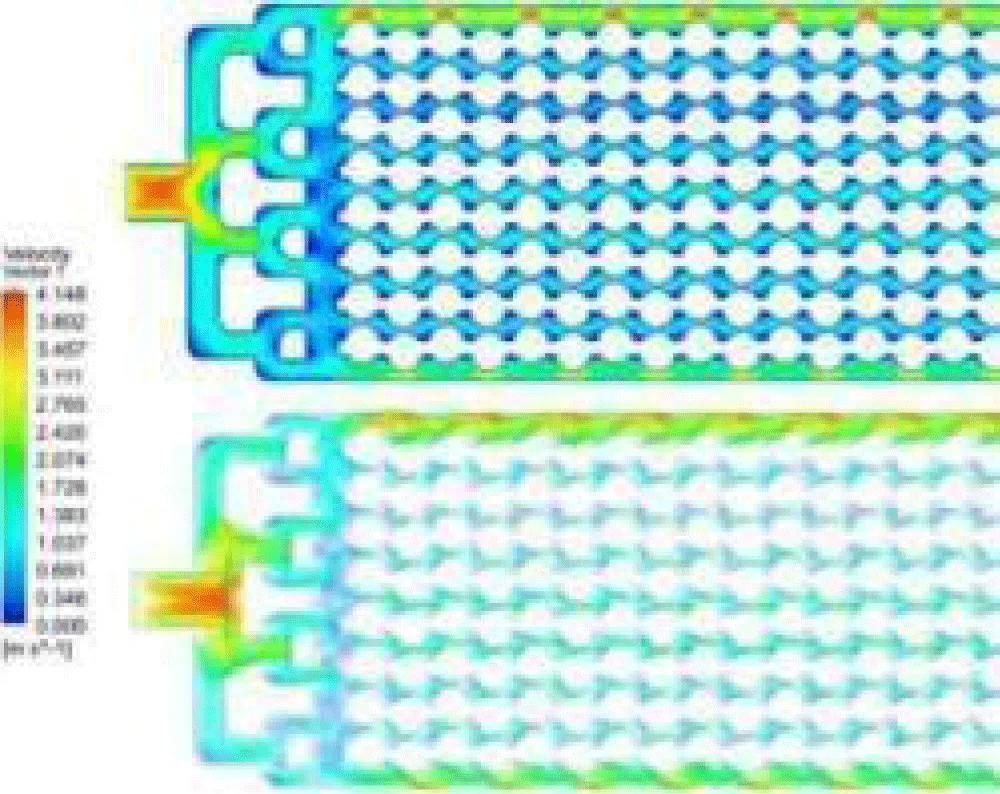Open Journal of Chemistry
The transformative role of Computational Fluid Dynamics (CFD) in chemical engineering
Bibhab Kumar Lodh*
Cite this as
Lodh BK (2024) The transformative role of Computational Fluid Dynamics (CFD) in chemical engineering. Open Journal of Chemistry 10(1): 001-003. DOI: 10.17352/ojc.000033Copyright
© 2024 Lodh BK. This is an open-access article distributed under the terms of the Creative Commons Attribution License, which permits unrestricted use, distribution, and reproduction in any medium, provided the original author and source are credited.Chemical engineering is a discipline intrinsically linked to fluid behavior. From reaction kinetics to reactor design, understanding how fluids flow, mix, and transfer heat is paramount. Traditionally, this relied heavily on experimentation, a time-consuming and resource-intensive process. The emergence of Computational Fluid Dynamics (CFD) has revolutionized the field, offering a powerful in-silico approach to analyze fluid dynamics in chemical engineering processes. This review paper explores the transformative role of CFD, examining its impact on various aspects of chemical engineering, including reactor design, optimization, process intensification, scale-up, and safety analysis. The paper also discusses the challenges associated with CFD simulations, ongoing advancements in the field, and potential future directions.
Introduction
Chemical engineering involves the design, development, and operation of processes that transform raw materials into valuable products. These processes often involve complex fluid flow phenomena, such as mixing, separation, heat transfer, and chemical reactions. Understanding and optimizing these phenomena is crucial for ensuring the efficiency, safety, and sustainability of chemical processes. Traditionally, chemical engineers relied on empirical correlations and physical experiments to study fluid flow in chemical processes. However, these methods can be expensive, and time-consuming, and may not always provide a comprehensive understanding of complex flow patterns. The advent of Computational Fluid Dynamics (CFD) has transformed the way chemical engineers approach fluid flow problems. CFD employs numerical methods to solve the governing equations of fluid mechanics (Navier-Stokes equations), allowing engineers to simulate fluid flow, heat transfer, and mass transfer in complex geometries under various operating conditions. This computational approach provides valuable insights into chemical processes, enabling engineers to optimize designs, troubleshoot problems, and explore new process concepts.
Impact of CFD on chemical engineering
The impact of CFD on chemical engineering is far-reaching and multifaceted. Some of the key areas where CFD has made significant contributions include:
Reactor design and optimization: Chemical reactors are the heart of chemical processes, providing the environment where reactants are converted into desired products. The design and optimization of reactors are critical for maximizing yields, minimizing by-products, and ensuring overall process efficiency. CFD plays a pivotal role in reactor design and optimization by providing detailed insights into flow patterns, mixing behavior, residence time distributions, temperature gradients, and reaction kinetics within reactors [1].
For instance, CFD simulations can be used to optimize the design of stirred-tank reactors, a common type of reactor used in the chemical industry. By simulating different impeller designs, agitation speeds, and baffle configurations, engineers can identify the optimal configuration for achieving uniform mixing, maximizing reaction rates, and minimizing stagnant zones [1]. CFD can also be utilized to design and optimize other types of reactors, such as packed-bed reactors, bubble columns, and fluidized bed reactors.
Process intensification: Process Intensification (PI) is a design philosophy aimed at achieving dramatic improvements in process efficiency, safety, and environmental impact by developing novel and compact equipment and process concepts. CFD plays a crucial role in PI by enabling engineers to explore and evaluate the feasibility of innovative process designs [2] (Figure 1).
One example of PI enabled by CFD is the development of microreactors. Microreactors offer several advantages over traditional reactors, including enhanced heat and mass transfer rates, improved control over reaction conditions, and the ability to perform rapid reactions with hazardous substances [2]. CFD simulations are essential for designing microreactors, optimizing their geometry and flow patterns, and ensuring uniform distribution of reactants within the microchannels. The image below illustrates how CFD simulations can be used to model the flow fields inside microreactors and optimize their configurations.
Scale-up: Scaling up a chemical process from a laboratory-scale experiment to a full-scale production plant is a challenging task. Changes in scale can significantly affect fluid flow patterns, mixing, heat transfer, and reaction kinetics, leading to unexpected problems during scale-up. CFD provides a valuable tool for understanding the impact of scale-up and mitigating potential risks [3]. Engineers can use CFD to simulate the performance of a reactor at different scales. By comparing the CFD results from a scaled-up model with the experimental data from the lab-scale reactor, they can identify potential issues related to flow patterns, mixing, and heat transfer. This information can guide the modification of the production-scale reactor design or the adjustment of operating parameters to minimize scale-up risks.
Safety analysis: Chemical processes often involve hazardous materials, flammable substances, and high temperatures and pressures. Ensuring the safety of these processes is a paramount concern for chemical engineers. CFD simulations can be a valuable tool for safety analysis by helping engineers predict potential hazards, design mitigation measures, and develop emergency response plans [4]. For example, CFD can be used to simulate the dispersion of flammable or toxic gases within a reactor building or process plant. This information can be used to design appropriate ventilation systems, place sensors, and develop evacuation procedures. Similarly, CFD can be used to analyze the potential for runaway reactions by simulating heat transfer and reaction kinetics within reactors and identifying potential hotspots or regions with poor mixing that could lead to thermal runaway.
Multiphase flow and complex systems: Many chemical processes involve multiphase flows, such as gas-liquid, liquid-liquid, or solid-liquid systems. Understanding and modeling multiphase flows is inherently complex due to the presence of interfaces, interfacial forces, and phase interactions. CFD has emerged as a powerful tool for simulating multiphase flows in chemical engineering applications [5].
CFD models for multiphase flows can be used to simulate various phenomena, such as bubble formation and coalescence in bubble column reactors, droplet breakup and coalescence in liquid-liquid extraction processes, and particle transport and deposition in slurry reactors. This information can help engineers design and optimize equipment for multiphase processes, improve mixing and mass transfer efficiency, and prevent fouling or sedimentation problems.
Challenges and advancements in CFD
Despite its transformative impact, CFD simulations are not without challenges. Some of the key challenges and ongoing research efforts include:
- Turbulence modelling: Turbulent flow is a complex phenomenon characterized by random fluctuations in velocity and pressure. Accurately simulating turbulent flow requires sophisticated mathematical models, such as Reynolds-Averaged Navier-Stokes (RANS) models, Large Eddy Simulation (LES), or Direct Numerical Simulation (DNS) [6]. The choice of turbulence model depends on the specific application, the desired level of accuracy, and the available computational resources.
- Validation of CFD models: CFD models are complex and rely on various assumptions, boundary conditions, and numerical schemes. It’s essential to validate CFD models against experimental data to ensure their accuracy and reliability. Model validation involves systematically comparing CFD predictions with experimental measurements under well-defined conditions [7].
- Multiphysics and multiscale modelling: Chemical processes often involve coupled phenomena, such as fluid flow, heat transfer, mass transfer, chemical reactions, and phase changes. Developing comprehensive CFD models that can capture these interactions at different length scales is an active area of research [8].
Research efforts are focused on developing improved turbulence models, advanced numerical methods, efficient coupling strategies for Multiphysics simulations, and leveraging high-performance computing (HPC) for large-scale CFD simulations.
Future directions
CFD is a rapidly evolving field with the potential to further revolutionize chemical engineering in the years to come. Some of the promising future directions include:
- Integration with Machine Learning and Artificial Intelligence: Applying machine learning (ML) and artificial intelligence (AI) techniques in conjunction with CFD offers opportunities for faster simulations, more accurate modeling, and better decision-making. ML algorithms can be used to learn from CFD data, identify patterns, and develop reduced-order models for rapid predictions [9].
- Data-Driven Process Optimization: Combining CFD with experimental data and process optimization algorithms enables data-driven approaches to improve the efficiency and sustainability of chemical processes. This can involve real-time monitoring, model updating, and intelligent control strategies to optimize operating conditions in response to changing conditions.
- Digital Twins and Virtual Prototyping: The concept of digital twins, which are virtual replicas of physical systems, is gaining traction in chemical engineering. CFD can be a key component of digital twins, allowing engineers to simulate different scenarios, test operating strategies, and optimize designs in a virtual environment before implementing changes in the real world [10].
Conclusion
Computational Fluid Dynamics (CFD) has become an indispensable tool for chemical engineers. Its ability to simulate complex fluid flow phenomena provides valuable insights into chemical processes, enabling engineers to design more efficient and safer reactors, optimize processes, scale up with confidence, and explore innovative process concepts. Despite challenges associated with turbulence modeling, model validation, and computational cost, CFD is a rapidly evolving field with the potential to continue transforming chemical engineering in the years to come. Future advancements in machine learning, big data analytics, and high-performance computing are expected to further enhance the capabilities of CFD, enabling smarter, more efficient, and more sustainable chemical processes.
- Ranade VV. Computational flow modeling for chemical reactor engineering. San Diego, CA: Academic Press. 2002.
- Hessel V, Löwe H, Schönfeld F. Microtechnical reactors for chemical synthesis. Chemical Engineering Science. 2005; 60(10):2479-2501.
- Basavarajappa M, Miskovic S, Majumder SK. Use of computational fluid dynamics in the design and scale‐up of industrial bioreactors. AIChE Journal. 2016; 62(4):1130-1147.
- Palazzi E, Fabiano B, Reverberi AP. Safety analysis using CFD modeling: A case study. Chemical Engineering Transactions. 2012; 26:335-340.
- Tabib MV, Roy SA, Joshi JB. CFD simulation of bubble column. An analysis of interphase forces and turbulence models. Chemical Engineering Journal. 2008; 139(3):589-614.
- Davidson L. An Introduction to Turbulence Models. Gothenburg, Sweden: Chalmers University of Technology. 2015.
- Schwer LE. Validation metrics for response histories: Perspectives and case studies. Engineering with Computers. 2007; 23(4):295-309.
- Kontogeorgis GM, Vlachos DG. Recent developments in multiscale, multiresolution modeling of chemical and biochemical systems. Current Opinion in Chemical Engineering. 2017; 18:78-88.
- Duraisamy K, Iaccarino G, Xiao H. Turbulence modeling in the age of data. Annual Review of Fluid Mechanics. 2019; 51(1):357-377.
- Lee J, Bagheri B, Kao HA. A cyber-physical systems architecture for industry 4.0-based manufacturing systems. Manufacturing Letters. 2015; 3:18-23.
Article Alerts
Subscribe to our articles alerts and stay tuned.
 This work is licensed under a Creative Commons Attribution 4.0 International License.
This work is licensed under a Creative Commons Attribution 4.0 International License.



 Save to Mendeley
Save to Mendeley
